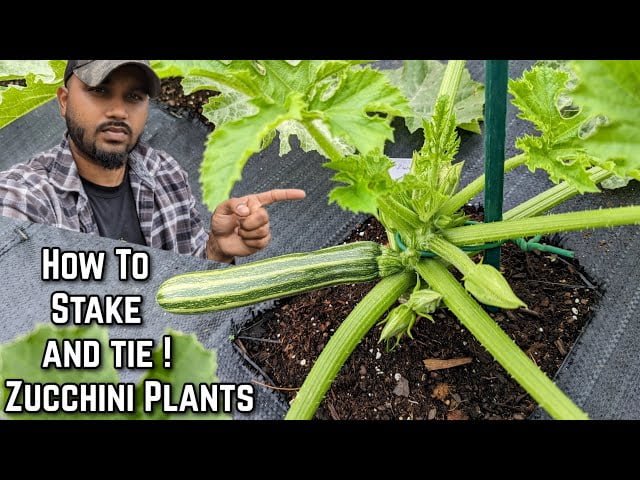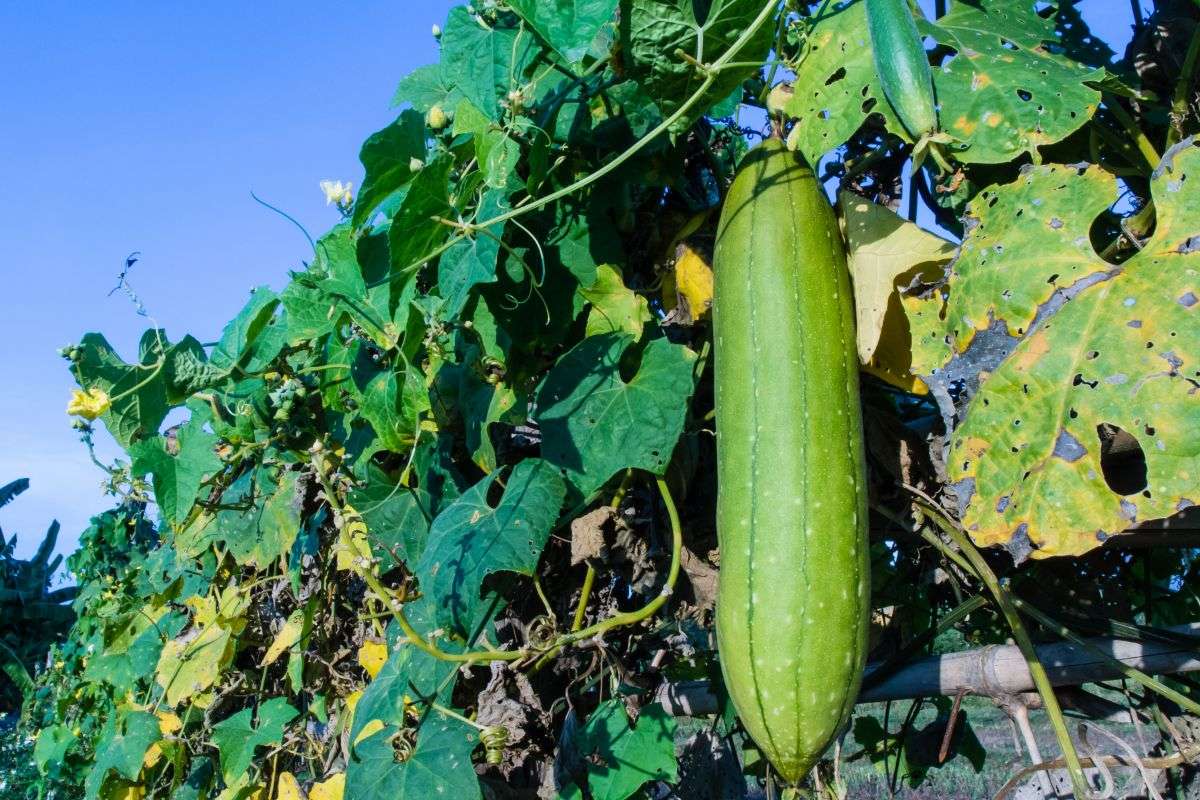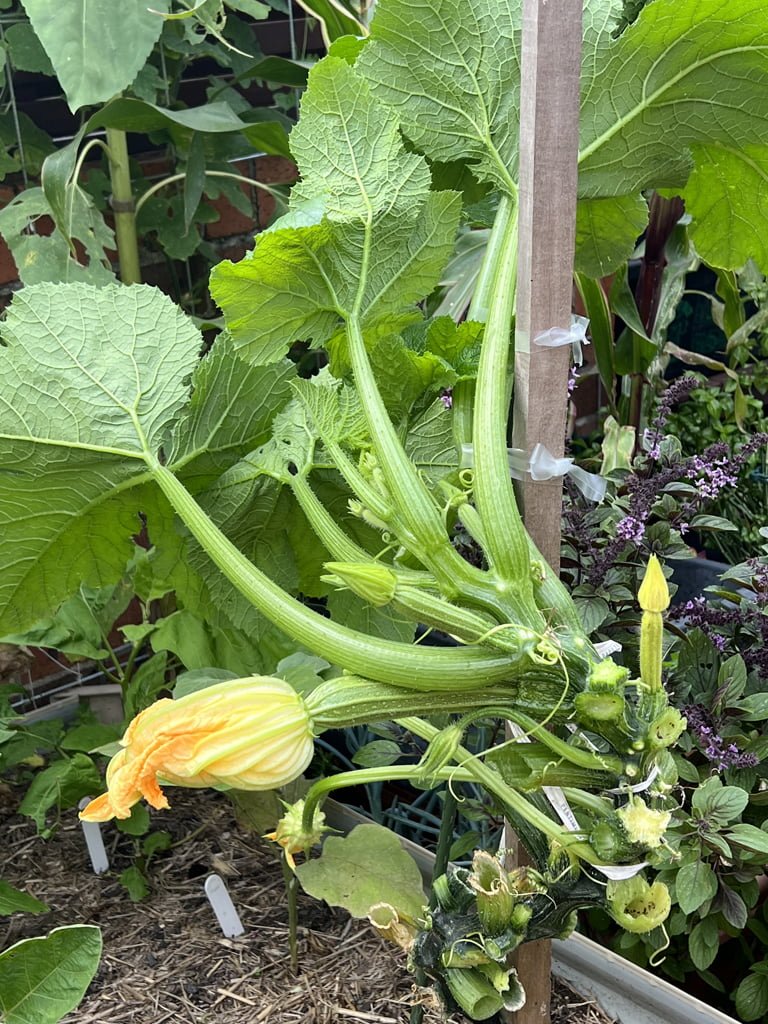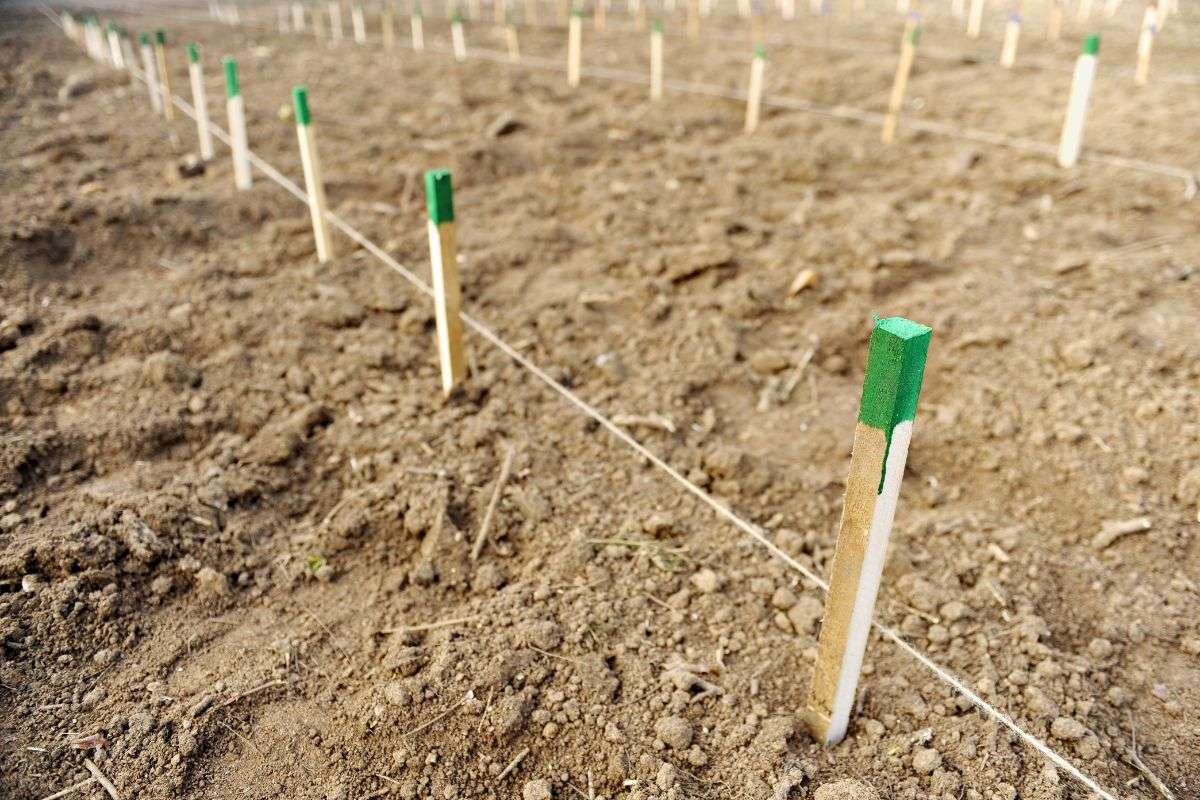Growing zucchini in your garden can be a rewarding and delicious experience, but it’s essential to ensure your plants are properly supported through the process. In this comprehensive guide, you will discover the ultimate techniques and tips for staking zucchini. From selecting the right stakes to securing your plants effectively, this article will equip you with the knowledge to promote healthy growth and maximize your zucchini harvest. So, get ready to elevate your zucchini game and enjoy a bountiful supply of this versatile vegetable all season long.

Choosing the Right Staking Method
When it comes to staking your zucchini plants, choosing the right method is crucial for their healthy growth and productivity. Staking zucchini offers numerous benefits, such as increasing air circulation around the plants, preventing rot and disease, and optimizing space utilization in your garden. Moreover, staking helps to keep the zucchini fruits off the ground, reducing the risk of damage or rot. Considering these advantages, let’s delve into the various staking methods available and how to make the best choice for your zucchini plants.
The Benefits of Staking Zucchini
Staking your zucchini plants provides several advantages that contribute to their overall health and productivity. Firstly, staking promotes proper air circulation, which is essential for preventing fungal diseases like powdery mildew. By elevating the zucchini fruits above the ground, staking also helps to reduce the risk of rot caused by moisture accumulation. Additionally, staking zucchini allows for better exposure to sunlight, which is crucial for optimal growth and fruit production. Choosing the appropriate staking method can significantly enhance these benefits and ensure a thriving zucchini harvest.
Considerations for Choosing a Staking Method
While staking zucchini has numerous advantages, it is vital to consider several factors when choosing the right method for your plants. One crucial consideration is the space available in your garden. Depending on the available area, you may opt for a staking method that requires vertical space, such as trellises or cages. Another factor to consider is the strength and stability of the staking material. Zucchini plants are known for their heavy foliage and large fruits, so it is essential to choose sturdy stakes or supports that can withstand the weight and withstand strong winds. Finally, the aesthetics of your garden can also play a role in choosing the staking method that best suits your preferences and complements your overall garden design.
Popular Staking Methods for Zucchini
There are several popular methods for staking zucchini, each with its own advantages and considerations. Let’s explore some of the most commonly used staking methods:
Wooden Stakes
Wooden stakes are a classic and versatile option for staking zucchini plants. Choose stakes that are at least four to six feet tall and approximately two inches in diameter to provide adequate support. Place the stakes about two feet apart along the row, ensuring stability by driving them into the ground at least one foot deep. Secure the zucchini plants to the stakes using soft ties or twine, gently guiding the plant upwards as it grows.
Metal Stakes
Metal stakes, such as rebar or metal rods, offer excellent durability and strength for staking zucchini plants. Similar to wooden stakes, drive the metal stakes into the ground at least one foot deep, positioning them approximately two feet apart along the row. Secure the zucchini plants to the stakes using soft ties or twine, ensuring they are well-supported as they grow.
Bamboo Poles
Bamboo poles are an eco-friendly choice for staking zucchini plants. They are lightweight, easily accessible, and offer reasonable strength. Use bamboo poles that are at least six feet tall and approximately one inch in diameter. Place the poles about two feet apart along the row, ensuring they are securely anchored in the ground. Tie the zucchini plants to the poles as they grow, providing steady support for their upward growth.
Cages
Cages provide excellent stability and support for zucchini plants, particularly for those gardeners with limited space. These sturdy structures are typically made of wire mesh or heavy-duty metal, forming a cage-like enclosure around the plant. Gently guide the zucchini plant’s vines through the cage openings as they grow, allowing them to be supported by the cage structure.
Trellises
Trellises offer an elegant and efficient way to stake zucchini plants while saving valuable garden space. Install a trellis system against a sturdy support, such as a wall or fence. As the zucchini plants grow, gently train the vines to climb up the trellis, ensuring they are securely attached using soft fabric ties or twine. Trellises not only provide excellent support but also add a decorative element to your garden.
Tomato Cages
Tomato cages, typically made of wire or metal, can be repurposed for staking zucchini plants. These cylindrical cages provide stability and support for the zucchini vines to grow upward. Position the cages around the zucchini plants, ensuring they are securely anchored in the ground. As the plants grow, gently guide the vines through the openings and secure them to the cage structure using soft ties or twine.

Preparing Your Zucchini Plant for Staking
Preparing your zucchini plant for staking is just as important as choosing the right method. Proper timing, pruning, and soil preparation are essential to ensure the successful growth and development of your zucchini plant. Let’s explore these aspects in detail:
Timing for Staking
It is crucial to stake your zucchini plants at the right time to avoid damaging the delicate young seedlings. Generally, wait until the plants have developed a few sets of true leaves and have established a sturdy stem before staking. This usually occurs when the plants reach a height of six to twelve inches or have been growing for a few weeks. However, ensure you stake your zucchini plants before they become too large or unruly, as this can make staking more challenging and increase the risk of damaging the roots during the process.
Pruning Your Zucchini Plant
Pruning is an essential step in preparing your zucchini plant for staking. Regular pruning helps to control the size of the plant, enhances air circulation, and promotes better fruit production. You can start pruning your zucchini plant when it has developed a few sets of true leaves. Begin by removing any lateral shoots or side branches that may be competing for nutrients and diverting energy from the main stem. Remove any damaged or diseased foliage and ensure the plant has a clean, well-ventilated appearance.
Preparing Soil for Staking
Before staking your zucchini plants, it is crucial to prepare the soil adequately. Ensure the soil is loose, well-draining, and enriched with organic matter. Work compost or well-rotted manure into the soil to improve its fertility and drainage. By preparing the soil properly, you create a favorable environment for your zucchini plant’s roots to develop and thrive. It is also beneficial to apply a layer of mulch around the base of the plant to suppress weeds, conserve moisture, and maintain a stable temperature.
Different Stakes and Supports for Zucchini
When it comes to staking zucchini plants, there are several types of stakes and supports to choose from. Each type offers distinct advantages and considerations. Let’s explore some popular options:
Wooden Stakes
Wooden stakes are a versatile and accessible option for staking zucchini plants. Opt for stakes that are at least four to six feet tall and approximately two inches in diameter to provide adequate support. Wooden stakes can be easily driven into the ground and offer excellent stability. However, it is important to choose rot-resistant wood, such as cedar or treated lumber, to ensure longevity and prevent rotting. Avoid using chemically treated wood if you plan to grow organic zucchini. Secure the zucchini plants to the stakes using soft ties or twine, gently guiding the plant upwards as it grows.
Metal Stakes
Metal stakes, such as rebar or metal rods, are a durable and long-lasting option for staking zucchini plants. These stakes provide excellent stability and can withstand the weight of the zucchini fruits. Drive the metal stakes into the ground at least one foot deep, positioning them approximately two feet apart along the row. It is important to choose stakes that are resistant to rust and corrosion, especially if you are in an area with high moisture levels. Secure the zucchini plants to the stakes using soft ties or twine, ensuring they have adequate support as they grow.
Bamboo Poles
Bamboo poles are an environmentally friendly choice for staking zucchini plants. They are lightweight, easily accessible, and offer reasonable strength. Use bamboo poles that are at least six feet tall and approximately one inch in diameter. Bamboo is naturally resistant to rot, making it an ideal option for organic gardeners. Drive the bamboo poles into the ground at least one foot deep, placing them approximately two feet apart along the row. Secure the zucchini plants to the poles using soft ties or twine, guiding them upwards as they grow.
Cages
Cages are a popular choice for staking zucchini plants, particularly for gardeners with limited space. These sturdy structures are typically made of wire mesh or heavy-duty metal, forming a cage-like enclosure around the plant. Cages provide excellent stability and support while allowing for easy access to the zucchini fruits. Place the cages around the zucchini plants, ensuring they are securely anchored in the ground. As the plants grow, guide the zucchini vines through the openings and encourage them to grow within the cage structure.
Trellises
Trellises offer an elegant and efficient way to stake zucchini plants, especially when space is a constraint. Install a trellis system against a sturdy support, such as a wall or fence. Trellises can be made from various materials, such as wood or metal, and come in a variety of designs. Choose a trellis that can withstand the weight of the zucchini vines and fruits. As the zucchini plants grow, gently train the vines to climb up the trellis, ensuring they are securely attached using soft fabric ties or twine. Trellises not only provide excellent support but also add a decorative aspect to your garden.
Tomato Cages
Tomato cages can be repurposed for staking zucchini plants, providing stability and support to help them grow upright. These cylindrical cages are typically made of wire or metal. Place the cages around the zucchini plants, ensuring they are securely anchored in the ground. As the plants grow, guide the zucchini vines through the openings and secure them to the cage structure using soft ties or twine. Tomato cages offer an easy and convenient staking solution, particularly if you already have them available in your garden.

Proper Staking Techniques
Proper staking techniques are vital to ensure the successful growth and support of your zucchini plants. Follow these steps to stake your zucchini plants effectively:
Determining the Placement of Stakes
Before staking your zucchini plants, determine the appropriate placement of the stakes. Consider the natural growth habit of the zucchini plant, which tends to have sprawling vines that can reach several feet in length. Position the stakes or supports along the row, ensuring they are evenly spaced and provide adequate support for the expanding plant. Take into account the size and spread of the zucchini plants and leave enough space between the stakes for the foliage to grow without becoming overcrowded.
Securing Stakes in the Ground
Once you have determined the placement of the stakes, it is important to secure them firmly in the ground. Use a mallet or a rubber mallet to drive the stakes into the soil, ensuring they are at least one foot deep for stability. Drive the stakes as vertically as possible to provide optimal support. If necessary, you can angle the stakes slightly towards the plant to accommodate the natural growth habit of zucchini vines. Ideally, the stakes should be positioned on the windward side of the plant to help support the foliage against strong winds.
Tying Up the Zucchini Plant
After securing the stakes, it is time to tie up the zucchini plant to provide support as it grows. Gently guide the main stem of the zucchini plant towards the stake or support, ensuring it remains upright. Use soft ties, twine, or strips of fabric to secure the stem to the stake, avoiding any tight or constricting ties that may damage the plant. Loosely tie the plant at regular intervals as it grows, providing support without restricting its natural growth. It is important to regularly check the ties and adjust them as needed to accommodate the plant’s increasing size.
Using Twine or Soft Fabric to Support
In addition to tying up the main stem, consider using twine or soft fabric to provide additional support for the zucchini plant. As the plant grows, gently guide the side branches or tendrils towards the stakes or supports, wrapping them loosely with twine or soft fabric to secure them in place. This technique helps to distribute the weight of the zucchini fruits and prevent the plant from becoming top-heavy. It is essential to handle the plant with care when using twine or fabric, ensuring they are not tied too tightly, which could damage the delicate foliage or restrict the plant’s natural growth.
Maintenance and Pruning
Proper maintenance and pruning are crucial to ensure the healthy growth and productivity of your staked zucchini plants. Regularly checking and adjusting supports, pruning excess foliage, removing suckers, and managing pest and disease concerns are essential maintenance tasks to keep your zucchini plants thriving.
Regularly Checking and Adjusting Supports
One of the most vital maintenance tasks for staked zucchini plants is regularly checking and adjusting the supports. As the plants grow, they may require additional support or adjustments to ensure they remain upright. Monitor the growth of the plants, checking for any signs of drooping or leaning. If necessary, provide additional soft ties or fabric support to secure the plant to the stakes or supports. Regularly inspect the ties and adjust them to accommodate the increasing size and weight of the zucchini plant.
Pruning Excess Foliage
Pruning excess foliage is an important practice to maintain proper air circulation and prevent the risk of fungal diseases. Zucchini plants are known for their vigorous growth and large leaves, which can sometimes become overcrowded. Regularly inspect your zucchini plants and remove any excess foliage, particularly those that are overcrowding the plant or shading the fruits. Use clean pruning shears or scissors to carefully remove the unwanted leaves or branches, ensuring to make clean cuts near the base of the plant.
Removing Suckers
Suckers are small, auxiliary shoots that can emerge from the leaf axils of zucchini plants. While some gardeners choose to leave these suckers, removing them can redirect the plant’s energy towards fruit production and overall plant health. To remove suckers, gently pinch or snap them off where they meet the main stem. Regularly monitor your zucchini plants to identify and remove any emerging suckers as they appear.
Managing Pest and Disease Concerns
Pest and disease management is a critical aspect of maintaining the health and productivity of your zucchini plants. Regularly inspect your plants for any signs of pests or diseases, such as yellowing leaves, holes in the foliage, or discoloration of the fruits. Identify common zucchini pests, such as aphids, cucumber beetles, and squash bugs, and promptly implement organic pest control methods to manage the infestation. It is also essential to recognize the symptoms of common zucchini diseases, such as powdery mildew or blossom end rot, and take appropriate measures to mitigate their impact on your plants.

Harvesting and Handling Zucchini
After nurturing your staked zucchini plants, it’s time to enjoy the fruits of your labor! Proper harvesting and handling techniques ensure that your zucchini remains fresh and flavorful. Follow these steps to harvest and handle your zucchini:
Recognizing When Zucchini is Ready to Harvest
Knowing when to harvest your zucchini is crucial to ensure optimal taste and texture. Regularly inspect your zucchini plants for mature fruits. Zucchini is typically ready to harvest when it reaches six to eight inches in length. The skin of ripe zucchini should be glossy and firm, while the fruit itself should still be tender. Avoid allowing your zucchini to grow too large, as they can become tough and less flavorful.
Harvesting Techniques
When it’s time to harvest your zucchini, use a sharp knife or garden shears to cut the fruit from the vine. Hold the zucchini with one hand, positioning the knife or shears close to the base of the fruit. Make a clean cut, being careful not to damage the vine or any nearby fruits. It is advisable to harvest zucchini in the morning when the fruit is cool and the plants are more turgid. This practice helps maintain the freshness and quality of the harvested zucchini.
Handling and Storing Zucchini Properly
To ensure the longevity and quality of your harvested zucchini, handle and store them properly. After harvest, gently rinse the zucchini under cool, running water to remove any dirt or debris. Pat them dry with a clean towel to minimize excess moisture, as dampness can lead to rot. Store the zucchini in a cool and dry location, such as the refrigerator’s crisper drawer. Alternatively, you can place them in a perforated plastic bag to maintain their freshness. Properly stored zucchini can last for up to a week, but it is best to consume them within a few days for optimal flavor and texture.
Tips and Tricks for Successful Zucchini Staking
To ensure a successful and bountiful zucchini harvest, consider incorporating these tips and tricks into your staking and cultivation practices:
Providing Proper Sun Exposure
Zucchini plants thrive in full sun, requiring a minimum of six to eight hours of direct sunlight each day. When selecting the location for your zucchini plants, choose a spot that receives ample sunlight and is sheltered from strong winds. Proper sun exposure promotes healthy growth, enhances fruit production, and reduces the risk of fungal diseases.
Using Organic Support Materials
If you prefer organic gardening practices, consider using organic support materials for staking your zucchini plants. Options such as bamboo poles, untreated wooden stakes, or natural fiber twine are excellent choices that align with organic gardening principles. By opting for organic support materials, you ensure that no harmful chemicals or synthetic materials come into contact with your zucchini plants.
Mulching and Watering
Mulching around your zucchini plants provides several benefits, including conserving soil moisture, suppressing weeds, and maintaining a stable temperature. Apply a layer of organic mulch, such as straw or wood chips, around the base of the plants, being careful not to cover the main stem or foliage. Additionally, ensure your zucchini plants receive adequate watering, providing them with approximately one inch of water per week. Apply water at the base of the plants, avoiding overhead watering that may promote fungal diseases.
Training Zucchini Vines
As your zucchini plants grow, proactively train the vines to direct their growth in a controlled and manageable manner. Gently guide the main stem and side branches towards the stakes or supports, ensuring they remain upright. Regularly inspect the plant and redirect any wayward growth by tying them to the supports or gently wrapping them around the stakes. By training the zucchini vines, you help prevent tangling or overcrowding, improving air circulation and overall plant health.

Common Mistakes to Avoid
While staking zucchini offers numerous benefits, it is important to avoid certain common mistakes that can hinder the success of your plants. By being aware of these pitfalls, you can ensure your zucchini plants thrive. Here are some common mistakes to avoid:
Insufficient Staking Support
One common mistake is providing inadequate staking support for your zucchini plants. Failing to choose sturdy and appropriate stakes or supports can result in the plants collapsing under the weight of their foliage and fruits. It is essential to consider the size and vigor of the zucchini plants when selecting the staking method, ensuring they have ample support to grow upright.
Waiting Too Long to Stake
Delaying the staking process can lead to unruly and sprawling zucchini plants. Staking should be done when the plants are still relatively small and manageable. Waiting too long may result in difficulty in securing the plants to the stakes or supports, potentially damaging the roots or stems. Therefore, it is important to stake your zucchini plants in a timely manner to ensure successful growth and support.
Overcrowding Zucchini Plants
Overcrowding zucchini plants is a common mistake that can hinder their growth and productivity. Zucchini plants require ample space to spread their foliage and fruits. Planting them too closely together can lead to poor air circulation, increased risk of diseases, and competition for nutrients and sunlight. It is advisable to provide sufficient spacing between zucchini plants, allowing for proper growth, airflow, and easy access for maintenance.
Neglecting Maintenance and Pruning
Neglecting regular maintenance and pruning can result in a multitude of problems for your zucchini plants. Without proper care, plants may become overcrowded, making air circulation difficult and increasing the risk of disease. Additionally, neglecting pruning can divert the plant’s energy towards excess foliage rather than fruit production. To ensure healthy and productive zucchini plants, it is important to consistently monitor and maintain them throughout their growth cycle.
Preventing Common Pest and Disease Issues
Preventing and managing pest and disease issues is crucial for the successful cultivation of zucchini plants. By implementing preventive measures and promptly addressing any concerns, you can minimize the impact on your plants. Consider the following strategies to prevent common pest and disease issues:
Identifying Common Zucchini Pests
Being able to identify common zucchini pests is the first step in preventing and managing infestations. Some common zucchini pests include aphids, cucumber beetles, squash bugs, and spider mites. Regularly inspect your plants for any signs of infestations, such as yellowing leaves, holes in foliage, or the presence of insects. Early detection and intervention can help prevent pests from spreading and causing significant damage.
Implementing Organic Pest Control Methods
Opting for organic pest control methods aligns with environmentally friendly gardening practices and helps preserve beneficial insects and pollinators. Some effective organic pest control methods for zucchini plants include handpicking or hosing off pests, introducing natural predators or beneficial insects, using organic sprays or repellents, and practising crop rotation. Avoiding chemical pesticides ensures the health and safety of your zucchini plants and the broader ecosystem.
Recognizing and Managing Disease Symptoms
Recognizing and managing disease symptoms is crucial in preventing the spread and severity of diseases that commonly affect zucchini plants. Some common zucchini diseases include powdery mildew, blossom end rot, and bacterial wilt. Regularly inspect your plants for any signs of disease, such as white powdery patches, browning or rotting fruits, or wilting leaves. Promptly address any disease concerns by employing appropriate management techniques, such as removing affected plant parts, improving air circulation, or applying organic disease control sprays.
Preventive Measures for Pest and Disease
Implementing preventive measures goes a long way in minimizing the risk of pest and disease infestations. Some preventive measures for your zucchini plants include practicing crop rotation, providing adequate spacing between plants, optimizing air circulation, removing weeds and debris that may harbor pests or diseases, and maintaining overall plant health through proper watering and fertilization. By proactively preventing pest and disease issues, you can safeguard the health and productivity of your zucchini plants.
Conclusion
Staking zucchini plants offers numerous benefits, such as improved air circulation, reduced disease risk, and optimal space utilization. By choosing the right staking method, preparing the plants appropriately, and incorporating proper staking techniques, you can ensure the successful growth and productivity of your zucchini plants. Regular maintenance, adequate pruning, and correct harvesting and handling techniques further contribute to a bountiful zucchini harvest. By avoiding common mistakes, preventing pest and disease issues, and incorporating the provided tips and tricks, you can enjoy a thriving zucchini garden and delicious homegrown produce. Happy staking and happy harvesting!



